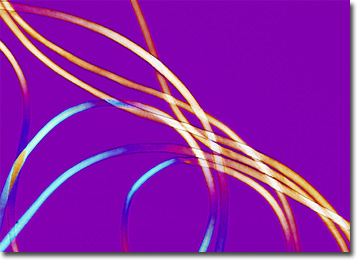Polarized Light Microscopy Digital Image Gallery
Merino Wool
For thousands of years, wool has been utilized to produce garments and other textiles. Throughout much of its long history of use, no wool has been more highly regarded than that of the merino sheep.

A number of sheep breeding nations, including Phoenicia, Italy, and Spain, are believed to have played a part in the development of the merino sheep. However, it is generally agreed upon that the Moors, who dominated Spain through the eighth to thirteenth centuries, were primarily responsible for selectively breeding the animals to such an extent that the wool they produced became superior to that of all other sheep. Indeed, the word merino may be of Moorish origin, possibly evolving from their word for a judge that settled disagreements about flocks between shepherds. By the eighteenth century, merino wool was considered so luxurious and valuable only the sovereign of Spain was permitted to send merino sheep out of the country, which he occasionally conveyed as gifts.
Today, merino wool woven into rugs and fine garments continues to be quite valuable, commanding high prices in the world market. The crimped, fine fibers of the wool are unusually soft and lustrous, as well as resistant to damage from ultraviolet radiation. In order to carry over some of these highly desirable characteristics into other materials, merino wool is sometimes blended with lesser-quality fibers. The merino sheep has also been utilized as the foundation for a number of other breeds that have been developed to meet various needs.
